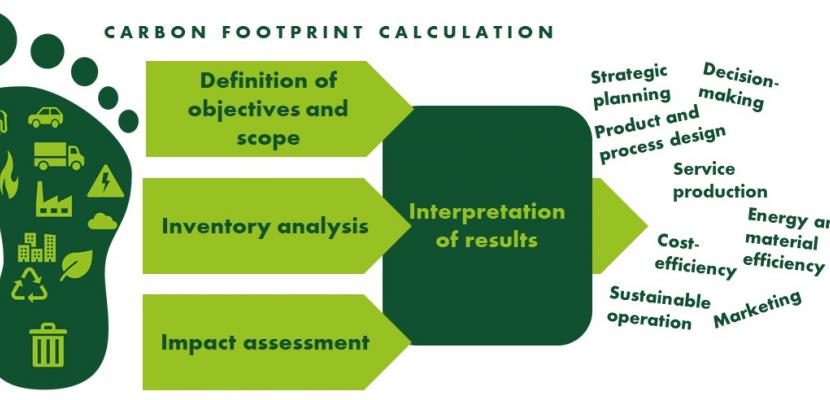A product’s carbon footprint refers to the total amount of greenhouse gas (GHG) emissions generated from the production, use, and disposal of that product. It is an indicator of the environmental impact of a product throughout its entire life cycle, from the extraction of raw materials to the production of the final product, its use, and eventual disposal. The carbon footprint of a product is usually expressed in units of carbon dioxide equivalents (CO2e) and takes into account all GHG emissions associated with the product, including carbon dioxide (CO2), methane (CH4), and nitrous oxide (N2O), among others.

Source: Interreg Europe (https://www.interregeurope.eu)
Calculating the carbon footprint of a product is a complex process that involves assessing all the activities and processes associated with the product, including the energy used in manufacturing, transportation, and distribution, as well as the emissions generated by the use of the product. The goal of calculating a product’s carbon footprint is to provide companies and consumers with information about the environmental impact of their products and to support decision-making about how to reduce emissions and improve sustainability.
To effectively manage their carbon footprint, organizations must have a deep understanding of the standards, methodologies for calculating their footprint, and best practices for reporting and verifying their results. The ISO 14067, ISO 14026, ISO 14040-44, and PAS 2050/2060 standards provide a comprehensive framework for organizations to measure and report their product carbon footprint.
This training course would provide participants with a comprehensive understanding of the key concepts, requirements, and methodologies for measuring and reporting carbon footprint. The course would cover the following topics in detail:
- Introduction to carbon footprint and GHG emissions: Participants would gain a solid understanding of what carbon footprint is, why it is important, and the implications of GHG emissions on the environment and climate change.
- Overview of ISO 14067, ISO 14026, ISO 14040-44, and PAS 2050/2060 standards: Participants would be introduced to the scope, objectives, and key requirements of the relevant standards, including their application, interpretation, and implementation.
- Requirements for carbon footprint measurement and reporting: Participants would learn about the key requirements for carbon footprint measurement and reporting, including the selection of appropriate methodologies, data collection, and analysis.
- Methodologies for calculating carbon footprint: Participants would be introduced to the various methodologies for calculating carbon footprint as well as their pros and cons.
- Data collection and analysis: Participants would learn about the process of data collection and analysis, including the identification of data sources, data quality, and data validation.
- Verification and certification of carbon footprint reports: Participants would learn about the process of verification and certification of carbon footprint reports, including the role of third-party verifiers and the process for obtaining certification.
- Auditing techniques and principles: Participants would be introduced to the best practices for auditing, including the planning and execution of audits, the identification of non-conformances, and the development of corrective action plans.
- Implementation and continuous improvement of carbon footprint management systems: Participants would learn about the best practices for the implementation and continuous improvement of carbon footprint management systems, including the development of an implementation plan, the establishment of performance metrics, and the ongoing monitoring and reporting of results.
Upon completion of this training course, participants would have the knowledge and skills required to effectively audit an organization’s product carbon footprint in accordance with the relevant standards. This would help organizations to reduce their emissions, improve their sustainability performance, and mitigate the impacts of climate change.
Contact CGLOBAL via below information to get your Carbon footprint training course
CGLOBAL IN U.S.A
GLOBAL INSPECTION AND CERTIFICATION NETWORK (CGLOBAL) LLC
Address in the establishment license: 3660 64th St. Sacramento, CA 95820, United States
Address of Transaction Office: 705 N A St, Easley, SC 29640-2141, United States
+ 1 (424) 570-3124 (USA)
Email: admin@cglobal.us
CGLOBAL IN EUROPE
Frankfurter Alle 213 10365 Berlin, Germany
+49 162 9888953
Email: europe.ger@cglobal.us
CGLOBAL IN ASEAN
GLOBAL INSPECTION AND CERTIFICATION NETWORK (CGLOBAL) PTE. LTD.
UEN: 202239887M
Adress: 470 NORTH BRIDGE ROAD #05-12, BUGIS CUBE, SINGAPORE (188735)
+65 3163 41091
Email: asean.sing@cglobal.us
CGLOBAL IN CHINA
2nd floor, 9 Luhu Road, Yuexiu District, Guangzhou 510095 China
+86 759 6653069
Email: china@cglobal.us
CGLOBAL IN VIETNAM
- GLOBAL INSPECTION AND CERTIFICATION NETWORK (CGLOBAL) JOINT STOCK COMPANY
2nd floor, Building Lot A03/D7, Cau Giay new urban area, Dich Vong Ward, Cau Giay District, Ha Noi city, Vietnam
+84 981 664 880
Email: vietnam@cglobal.us
- TQC CGLOBAL CENTER FOR TESTING AND CERTIFICATION
Address in the establishment license: 127/30/8, Lane 127, Van Cao Street, Lieu Giai ward, Ba Dinh district, Hanoi.
Address of Transaction Office in Hanoi: No 51, Lane 140/1, Nguyen Xien street, Ha Dinh ward, Thanh Xuan district, Hanoi City
Tel: 0981 002 880
Email: info@tqc.vn
CGLOBAL IN CAMBODIA
#6 Street D, Krang Tnorng Sangkat, Sen Sok Khan, Phnom Penh, Cambodia
+855 97 785 5953
Email: cambodia@cglobal.us


